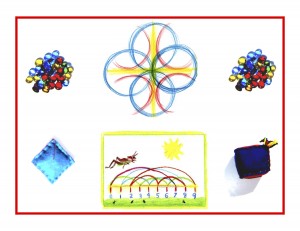Day 121
For one year, 365 days, this blog will address the Common Core Standards from the perspective of creating an alternate, ambient learning environment for math. Ambient is defined as “existing or present on all sides, an all-encompassing atmosphere.” And ambient music is defined as: “Quiet and relaxing with melodies that repeat many times.
Why ambient? A math teaching style that’s whole and all encompassing, with themes that repeat many times through the years, is most likely to be effective and successful. Today’s post features the Common Core Grade 2 overview in blue, followed by its ambient counterpart as practiced by Waldorf Education and Math By Hand.
Operations and Algebraic Thinking
Represent and solve problems involving addition and subtraction.
Add and subtract within 20.
Work with equal groups of objects to gain foundations for multiplication.
The 4 processes are taught and learned side by side from the very beginning. Equations are written horizontally at first in Grade 1, as number sentences. Single digits totaling no more than 20 are worked with in addition, subtraction, multiplication, and division. After briefly reviewing the Grade 1 content at the beginning of Grade 2, the horizontal format is changed to vertical, using double digits with no regrouping, in all 4 processes up to 100. No need to build foundations for multiplication as it’s been included from the beginning.
Number and Operations in Base Ten
Understand place value.
Use place value understanding and properties of operations to add and subtract.
In Grade 2, place value is taught in the second of four math blocks, using hands-on materials and manipulatives. Place value understanding is used primarily in regrouping with addition and subtraction. Regrouping is also used with short multiplication and division until mid-Grade 3 when their long versions are taught.
Measurement and Data
Measure and estimate lengths in standard units.
Relate addition and subtraction to length.
Work with time and money.
As stated in an earlier post, time and measurement wait until Grade 3 in both the Waldorf and Math By Hand systems. Though must children will be somewhat familiar with both, it’s best to hold off formal instruction until age 9, when the optimal developmental readiness allows maximum retention and understanding. However, foundational activities in both areas may be both doable and helpful.
Geometry
Reason with shapes and their attributes.
As has been previously shown, form drawing is more than adequate to address this standard.
Teaching in blocks is a wonderfully efficient way to cover all academics, while having the afternoons free for the fun, creative stuff. Knowledge ensues in an environment dedicated to imaginative, creative knowing, where student and teacher alike surrender to the ensuing of knowledge as a worthy goal. Tune in tomorrow for a suggested Grade 2 full-year block plan.












